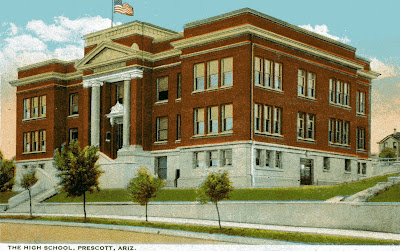The Elk's theater and opera house opening in 1905, was built by the Benevolent and Protective Order of
 Elks. The three story structure cost $65,000. I think the top floor served the Elks Lodge with offices on the second, and the theater of course, on the ground level.
Elks. The three story structure cost $65,000. I think the top floor served the Elks Lodge with offices on the second, and the theater of course, on the ground level.Inside, seats that could be easily removed to make room for ballroom dancing provided seating for around 900 people.
The fancy decor was green and gold with Elk's head logos highlighting each of the box seats on the sides of the stage. This theater was a hub for community life where graduation ceremonies and school plays were held.
There were also professional plays and acts. Madame Ernestine Schumann-Heink the lauded German diva performed there. Parker Anderson has written a very fun account of her visit to Prescott.

According to Parker Anderson, in 1910 the Elks recognized that Charles Howard's Electric Theater housed in the Head Hotel, had been drawing the majority of the entertainment business by featuring Vaudeville acts and short movie clips.
Since the Opera house had proved to be less "of a financial boon" than they'd expected, the Elks hired Charles Howard to manage their less successful Theater. He promptly closed the Electric Theater and Vaudeville acts and movies were then shown at the Elks theater seven nights a week.
When we moved to Prescott in 1947, the Elks theater was the place to see movies like Gone With the Wind, Leave Her to Heaven and All the King's Men while the Studio Theater, once standing on the corner of Cortez and Union, was the place Prescott kids congregated every Saturday afternoon to watch westerns staring Roy Rogers, Gene Autry, and Audie Murphy. We were also spellbound by Johnny Weismuller in Tarzan of the Apes and my personal tropical favorite Kay Aldridge as Nyoka the Jungle Girl.
******************************
I thought this would be a good time to include this picture of the Yavapai Club. The interesting thing is that this building looks quite different than the building across Marina Street from the Carnegie Library in the top photo. I don't know when this building was built, but it was a "gentleman's club" built by Frank Murphy that included a restaurant, games room, library, sleeping accommodations, and even a bowling alley. It had a ballroom and a library. Yavapai club members were local businessmen.

I think this is the oldest picture and the building in the top photo is a remodel although this one looks like it has more room....Hmmmm What do you think??
The building shown peeking out on the east of the Yavapai Club, between it and the old Capitol Building, was the Drake Opera House formerly S.E. Patton's Opera House. I don't think I've seen a picture of it in the whole.





































